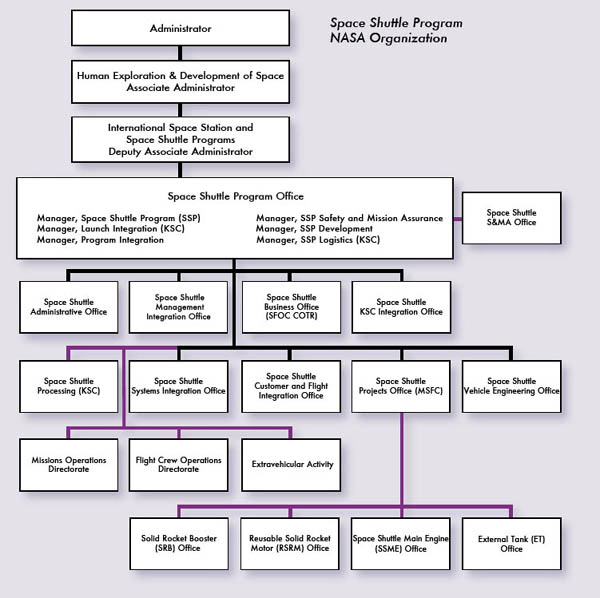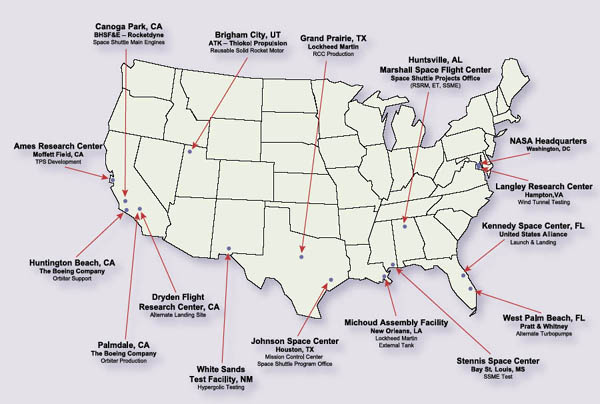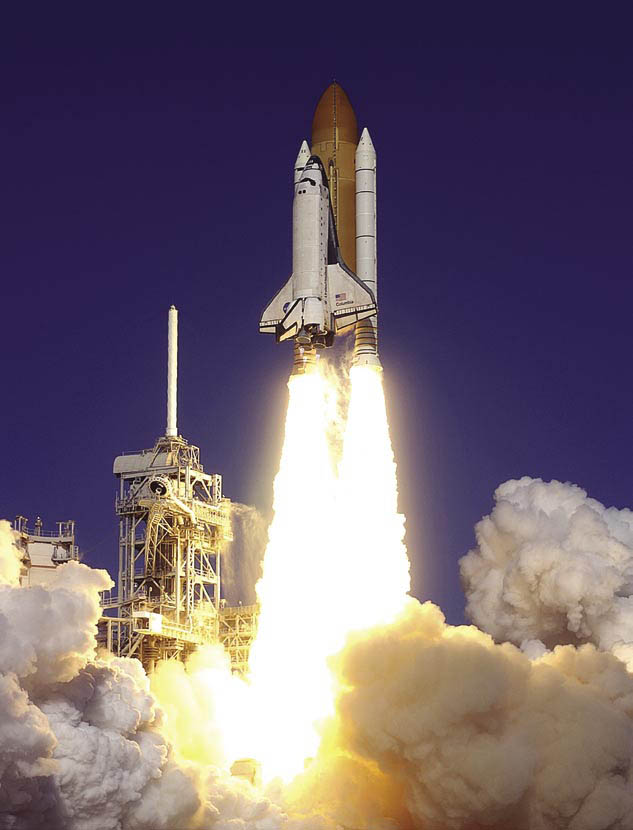AN INTRODUCTION TO NASA
―NASAの基礎知識―
―NASAの基礎知識―
"An Act to provide for research into the problems of flight within and outside the Earths atmosphere, and for other purposes." With this simple preamble, the Congress and the President of the United States created the National Aeronautics and Space Administration (NASA) on October 1, 1958. Formed in response to the launch of Sputnik by the Soviet Union, NASA inherited the research-oriented National Advisory Committee for Aeronautics (NACA) and several other government organizations, and almost immediately began working on options for manned space flight. NASAs first high profile program was Project Mercury, an early effort to learn if humans could survive in space. Project Gemini followed with a more complex series of experiments to increase mans time in space and validate advanced concepts such as rendezvous. The efforts continued with Project Apollo, culminating in 1969 when Apollo 11 landed the first humans on the Moon. The return from orbit on July 24, 1975, of the crew from the Apollo-Soyuz Test Project began a six-year hiatus of American manned space flight. The launch of the first Space Shuttle in April 1981 brought Americans back into space, continuing today with the assembly and initial operations of the International Space Station.
「地球の大気の内側と外側の両方での飛行に関する問題などを対象とする研究活動」このシンプルな前言とともに、1958年10月1日、連邦議会とアメリカ合衆国大統領はアメリカ航空宇宙局(National Aeronautics and Space Administration:NASA)を設立しました。NASAは、ソ連のスプートニクの打上げに対抗することを目的とし、研究機関であるアメリカ航空諮問委員会(National Advisory Committee for Aeronautics:NACA)、およびその他の政府機関の活動を引き継ぐものでした。そして、設立後すぐにNASAは有人宇宙飛行という選択肢を取ります。NASAの最初の大きなプログラムはマーキュリー計画でした。これは、人間が宇宙で生きていけるかどうかを探る最初期の試みです。続くジェミニ計画は、人間の宇宙滞在の時間を延ばすより複雑な実験と、ランデブーのような、より高度なコンセプトを確認するものです。これらの試みは、アポロ計画でも継続され、1969年アポロ11号による最初の有人月面着陸で頂点を迎えます。そして、1975年7月24日、アポロ・ソユーズテスト計画のクルーが軌道上から帰還した後、有人宇宙飛行は6年間中断されます。1981年4月、最初のスペースシャトルの打上げにより、アメリカは宇宙に戻ることになりました。そして、現在も国際宇宙ステーションの組立と初期の運用が続けられています。
In addition to the human space flight program, NASA also maintains an active (if small) aeronautics research program, a space science program (including deep space and interplanetary explora-tion), and an Earth observation program. The agency also conducts basic research activities in a variety of fields.
有人宇宙飛行に加えて、NASAは(小規模ながら)航空工学に関する積極的な研究活動、宇宙科学(ここには、深宇宙や惑星間探査などが含まれます)、地球探査を行っており、さらに多くの分野において基礎研究を行っています。
NASA, like many federal agencies, is a heavily matrixed organization, meaning that the lines of authority are not necessarily straight-forward. At the simplest level, there are three major types of entities involved in the Human Space Flight Program: NASA field centers, NASA programs carried out at those centers, and industrial and academic contractors. The centers provide the buildings, facilities, and support services for the various programs. The programs, along with field centers and Headquarters, hire civil servants and contrac-tors from the private sector to support aspects of their enterprises.
意思決定のラインがストレートではないという意味で、他の連邦政府期間と同じように、NASAも非常に錯綜した組織といえるでしょう。最も単純なレベルでは、有人宇宙飛行計画に関わっているのは、次の3つのグループです。NASAのフィールドセンター(NASAのプログラムを実行しているのはここです)、そして産業分野と学術分野、それぞれの業務委託先です。フィールドセンターは建物や施設、サポートサービスを様々なプログラムのために提供します。それらのプログラムには、フィールドセンターとNASA本部に加えて、彼らの事業を支援するという意味で、公務員や契約企業などが民間から雇われることになります。

THE LOCATIONS
THE LOCATIONS ―ロケーション―
NASA Headquarters, located in Washington D.C., is responsible for leadership and management across five strategic enterprises: Aero-space Technology, Biological and Physical Research, Earth Science, Space Science, and Human Exploration and Development of Space. NASA Headquarters also provides strategic management for the Space Shuttle and International Space Station programs.
NASAの本部は、ワシントンD.C.に置かれており、5つの事業部―航空宇宙工学、生物・物理学、地球科学、宇宙科学、そして有人探査および宇宙開発―を統括しています。また、NASAはスペースシャトルと国際宇宙ステーションプログラムに対する戦略的なマネジメントも行っています。
The Johnson Space Center in Houston, Texas, was established in 1961 as the Manned Spacecraft Center and has led the development of every U.S. manned space flight program. Currently, Johnson is home to both the Space Shuttle and International Space Station Pro-gram Offices. The facilities at Johnson include the training, simula-tion, and mission control centers for the Space Shuttle and Space Station. Johnson also has flight operations at Ellington Field, where the training aircraft for the astronauts and support aircraft for the Space Shuttle Program are stationed, and manages the White Sands Test Facility, New Mexico, where hazardous testing is conducted.
テキサス州ヒューストンのジョンソン宇宙センターは、1961年に有人宇宙船センターとして設立され、アメリカの有人宇宙飛行プログラムは全て、ここで行われてきました。現在、ジョンソン宇宙センターはスペースシャトルと国際宇宙ステーションプログラムのオフィスが設置されています。ここには、スペースシャトルのトレーニングやシミュレーションの施設、スペースシャトルと宇宙ステーションのミッションコントロールセンターが置かれています。さらに、エリントンフィールドにはフライトオペレーションが置かれ、宇宙飛行士の訓練用の航空機やスペースシャトルのサポート用の航空機が置かれています。さらにジョンソン宇宙センターはニューメキシコ州ホワイトサンズのテスト施設も運用しており、ここでは、危険度の高いテストが行われています。
The Kennedy Space Center was created to launch the Apollo missions to the Moon, and currently provides launch and landing facilities for the Space Shuttle. The Center is located on Merritt Island, Florida, adjacent to the Cape Canaveral Air Force Station that also provides support for the Space Shuttle Program (and was the site of the earlier Mercury and Gemini launches). Personnel at Kennedy support maintenance and overhaul services for the Orbiters, assemble and check-out the integrated vehicle prior to launch, and operate the Space Station Processing Facility where components of the orbiting laboratory are packaged for launch aboard the Space Shuttle. The majority of contractor personnel assigned to Kennedy are part of the Space Flight Operations Contract administered by the Space Shuttle Program Office at Johnson.
ケネディ宇宙センターは、月を目指したアポロ計画の打上げのために作られ、現在はスペースシャトルの打上げと着陸のための施設を提供しています。フロリダ州のメリットアイランドに位置し、同じくスペースシャトルの支援を行っているケープカナベラル空軍基地(ここは、マーキュリーやジェミニが打ち上げられた場所でもあります)に隣接しています。ケネディ宇宙センターの職員はオービターのメンテナンスとオーバーホール、さらに打上げ前の組立とチェックを行います。また、スペースステーション組立棟では、スペースシャトルに乗せて打ち上げるために、軌道上の実験施設のコンポーネントを荷造りする作業をしています。宇宙飛行計画規約の一環として、ケネディ宇宙センターに配属されている委託職員は、スペースシャトルプログラムのオフィスで監理されています。
The Marshall Space Flight Center, near Hunstville, Alabama, is home to most NASA rocket propulsion efforts. The Space Shuttle Projects Office located at Marshall--organizationally part of the Space Shuttle Program Office at Johnson--manages the manufacturing and support contracts to Boeing Rocketdyne for the Space Shuttle Main Engine (SSME), to Lockheed Martin for the External Tank (ET), and to ATK Thiokol Propulsion for the Reusable Solid Rocket Motor (RSRM, the major piece of the Solid Rocket Booster). Marshall is also involved in microgravity research and space product development programs that fly as payloads on the Space Shuttle.
アラバマ州ハンツヴィル近郊のマーシャル宇宙飛行センターは、NASAのロケット燃料研究の故郷です。マーシャルのスペースシャトルプロジェクトのオフィス(組織的にはジョンソンのスペースシャトルプロジェクトオフィスの一部ですが)は、ボーイングロケットダインとのスペースシャトルメインエンジン(SSME)について、ロッキードマーティンとは外部燃料タンクについて、さらにATKツィオコルプロパルジョンとは再利用型固体燃料ロケットモーター(RSRM、固体燃料ロケットブースターの主要部分です)についての製造とサポートの契約を監理しています。マーシャルはスペースシャトルの積荷の一部としてフライト行ってい微小重力環境研究および製品製造プログラムに関わっています。
The Stennis Space Center in Bay St. Louis, Mississippi, is the largest rocket propulsion test complex in the United States. Stennis provides all of the testing facilities for the Space Shuttle Main Engines and External Tank. (The Solid Rocket Boosters are tested at the ATK Thiokol Propulsion facilities in Utah.)
ミシシッピ州セントルイス湾のステニス宇宙センターは、アメリカで最も大きいロケット燃料テスト施設です。ステニスは全てのスペースシャトルメインエンジンと外部燃料タンクのテストを行っています(固体燃料ロケットのテストはユタ州のATKツィオコル・プロパルジョンの施設で行われます)。
The Ames Research Center at Moffett Field, California, has evolved from its aeronautical research roots to become a Center of Excellence for information technology. The Centers primary importance to the Space Shuttle Program, however, lies in wind tunnel and arc-jet testing, and the development of thermal protection system concepts.
カルフォルニア州モフェットフィールドのエイムズ研究センターは、元々航空工学の研究をルーツとして発達し、今では、情報技術に関する最先端の研究が行われています。ここはスペースシャトルプログラムで最も重要な役割を果たしており、風洞実験とアークジェットテストが行われ、耐熱システムの開発が行われています。
The Langley Research Center, at Hampton, Virginia, is the agencys primary center for structures and materials and supports the Space Shuttle Program in these areas, as well as in basic aerodynamic and thermodynamic research.
ヴァージニア州ハンプトンのラングレー研究センターは、スペースシャトルプログラムの構造と素材研究の中心であり、この分野に関するサポートを行っています。また、空気力学と熱力学の基礎研究が行われています。

THE PROGRAMS
THE PROGRAMS ―プログラム―
The two major human space flight efforts within NASA are the Space Shuttle Program and International Space Station Program, both headquartered at Johnson although they report to a Deputy Associate Administrator at NASA Headquarters in Washington, D.C.
NASAの主要な有人宇宙飛行への試みは2つ。スペースシャトルプログラムと国際宇宙ステーションプログラムです。どちらもジョンソン宇宙センターが本部となっていますが、ワシントンのNASA本部にいる準理事代理に報告されることになっています。
The Space Shuttle Program Office at Johnson is responsible for all aspects of developing, supporting, and flying the Space Shuttle. To accomplish these tasks, the program maintains large workforces at the various NASA Centers that host the facilities used by the program. The Space Shuttle Program Office is also responsible for managing the Space Flight Operations Contract with United Space Alliance that provides most of the contractor support at Johnson and Kennedy, as well as a small amount at Marshall.
ジョンソンにあるスペースシャトルプログラムのオフィスは、開発、支援、スペースシャトルの飛行の全ての側面において責任をもっています。これらの業務を完遂するために、これらのプログラムが使用する様々な施設で、膨大な労働力が維持されています。また、このオフィスはユナイテッドスペースアライアンスとの宇宙飛行運用契約の管理について責任をもっています。ユナイテッドスペースアライアンスは、ジョンソンとケネディの両宇宙センターのほとんど全て、そしてマーシャル宇宙飛行センターでもわずかながら行われている契約企業による支援を提供しています。
THE CONTRACTORS
THE CONTRACTORS ―契約企業―
The Space Shuttle Program employs a wide variety of commercial companies to provide services and products. Among these are some of the largest aerospace and defense contractors in the country, in-cluding (but not limited to):
スペースシャトルプログラムは、広く様々な分野の営利企業と契約をし、それらの商品やサービスを確保しています。これらの企業の中には、以下のような、この国の最も大きな航空宇宙と国防関連の企業が含まれています(もちろん、これらの企業に限定されているわけではありません)
United Space Alliance
This is a joint venture between Boeing and Lockheed Martin that was established in 1996 to perform the Space Flight Operations Contract that essentially conducts the day-to-day operation of the Space Shuttle. United Space Alliance is headquartered in Houston, Texas, and employs more than 10,000 people at Johnson, Kennedy, and Marshall. Its contract currently runs through 2005.
This is a joint venture between Boeing and Lockheed Martin that was established in 1996 to perform the Space Flight Operations Contract that essentially conducts the day-to-day operation of the Space Shuttle. United Space Alliance is headquartered in Houston, Texas, and employs more than 10,000 people at Johnson, Kennedy, and Marshall. Its contract currently runs through 2005.
ユナイテッド・スペース・アライアンス(USA)
United Space Alliance
これは、ボーイングとロッキード・マーティンの間で設立されたジョイントベンチャーで、1996年に宇宙飛行運用契約を実施するために設立されました。この規約は実質は、スペースシャトルの日々の運用を管理するためのものでした。ユナイテッド・スペース・アライアンスはテキサス州ヒューストンに本部を置き、10,000の従業員がジョンソン、ケネディ、マーシャルの各センターで働いています。この契約は2005年まで続くことになっています。
United Space Alliance
これは、ボーイングとロッキード・マーティンの間で設立されたジョイントベンチャーで、1996年に宇宙飛行運用契約を実施するために設立されました。この規約は実質は、スペースシャトルの日々の運用を管理するためのものでした。ユナイテッド・スペース・アライアンスはテキサス州ヒューストンに本部を置き、10,000の従業員がジョンソン、ケネディ、マーシャルの各センターで働いています。この契約は2005年まで続くことになっています。
※訳注:宇宙飛行運用契約というのは、1996年にシャトルの運用の民間委託をするために締結されたもの。現在はこの契約にもとづき、民間企業がシャトルの運用を担当し、NASAがそれを統括するという形が取られています。
The Boeing Company, NASA Systems
The Space Shuttle Orbiter was designed and manufactured by Rockwell International, located primarily in Downey and Palmdale, California. In 1996, The Boeing Company purchased the aerospace assets of Rockwell International, and later moved the Downey op-eration to Huntington Beach, California, as part of a consolidation of facilities. Boeing is subcontracted to United Space Alliance to provide support to Orbiter modifications and operations, with work performed in California, and at Johnson and Kennedy.
The Space Shuttle Orbiter was designed and manufactured by Rockwell International, located primarily in Downey and Palmdale, California. In 1996, The Boeing Company purchased the aerospace assets of Rockwell International, and later moved the Downey op-eration to Huntington Beach, California, as part of a consolidation of facilities. Boeing is subcontracted to United Space Alliance to provide support to Orbiter modifications and operations, with work performed in California, and at Johnson and Kennedy.
ボーイング、NASAシステムズ
The Boeing Company, NASA Systems
スペースシャトルオービターは、カルフォルニア州パームデールとダウニーのロックウェルインターナショナルによって設計、製造されました。1996年ボーイングがロックウェルインターナショナルの航空宇宙部門を買い取り、後に、施設が統合され、ダウニーから同じカルフォルニア州のハンチントンビーチへ移りました。ボーイングはユナイテッド・スペース・アライアンスの下請けをしており、カルフォルニアと、ジョンソン、ケネディの両宇宙センターにおいて、オービターの改修と運用の支援を受け持っています。
The Boeing Company, NASA Systems
スペースシャトルオービターは、カルフォルニア州パームデールとダウニーのロックウェルインターナショナルによって設計、製造されました。1996年ボーイングがロックウェルインターナショナルの航空宇宙部門を買い取り、後に、施設が統合され、ダウニーから同じカルフォルニア州のハンチントンビーチへ移りました。ボーイングはユナイテッド・スペース・アライアンスの下請けをしており、カルフォルニアと、ジョンソン、ケネディの両宇宙センターにおいて、オービターの改修と運用の支援を受け持っています。
The Boeing Company, Rocketdyne Propulsion & Power
The Rocketdyne Division of Rockwell International was responsi-ble for the development and manufacture of the Space Shuttle Main Engines, and continues to support the engines as a part of The Boe-ing Company. The Space Shuttle Projects Office at Marshall man-ages the main engines contract, with most of the work performed in California, Stennis, and Kennedy.
The Rocketdyne Division of Rockwell International was responsi-ble for the development and manufacture of the Space Shuttle Main Engines, and continues to support the engines as a part of The Boe-ing Company. The Space Shuttle Projects Office at Marshall man-ages the main engines contract, with most of the work performed in California, Stennis, and Kennedy.
ボーイング、ロケットダイン・プロパルジョン・アンド・パワー
The Boeing Company, Rocketdyne Propulsion & Power ロックウェル・インターナショナルのロケットダイン部門はスペースシャトルメインエンジンの開発と製造を担当しました。そして、現在もボーイングの一部門としてエンジンのサポートを行っています。このメインエンジンに関する契約と、カルフォルニア、ステニス、そしてケネディで行われているメインエンジンに関する業務のほぼ全てをについては、マーシャルのスペースシャトルプロジェクトオフィスで管理されています。
The Boeing Company, Rocketdyne Propulsion & Power ロックウェル・インターナショナルのロケットダイン部門はスペースシャトルメインエンジンの開発と製造を担当しました。そして、現在もボーイングの一部門としてエンジンのサポートを行っています。このメインエンジンに関する契約と、カルフォルニア、ステニス、そしてケネディで行われているメインエンジンに関する業務のほぼ全てをについては、マーシャルのスペースシャトルプロジェクトオフィスで管理されています。
ATK Thiokol Propulsion
ATK Thiokol Propulsion (formerly Morton-Thiokol) in Brigham City, Utah, manufactures the Reusable Solid Rocket Motor seg-ments that are the propellant sections of the Solid Rocket Boosters. The Space Shuttle Projects Office at Marshall manages the Reus-able Solid Rocket Motor contract.
ATK Thiokol Propulsion (formerly Morton-Thiokol) in Brigham City, Utah, manufactures the Reusable Solid Rocket Motor seg-ments that are the propellant sections of the Solid Rocket Boosters. The Space Shuttle Projects Office at Marshall manages the Reus-able Solid Rocket Motor contract.
ATK ツィオコル・プロパルジョン
ATK Thiokol Propulsion
ATK ツィオコル・プロパルジョン(以前はモートン・ツィオコルでした)はユタ州のブリガムシティにあり、固体燃料ロケットブースターの燃料部分である、再利用型固体燃料ロケットモーターの製造を行っています。この再利用型固体燃料ロケットモーターに関する契約は、マーシャルのスペースシャトルプロジェクトオフィスで管理されています。
ATK Thiokol Propulsion
ATK ツィオコル・プロパルジョン(以前はモートン・ツィオコルでした)はユタ州のブリガムシティにあり、固体燃料ロケットブースターの燃料部分である、再利用型固体燃料ロケットモーターの製造を行っています。この再利用型固体燃料ロケットモーターに関する契約は、マーシャルのスペースシャトルプロジェクトオフィスで管理されています。
Lockheed Martin Space Systems, Michoud Operations
The External Tank was developed and manufactured by Martin Marietta at the NASA Michoud Assembly Facility near New Orleans, Louisiana. Martin Marietta later merged with Lockheed to create Lockheed Martin. The External Tank is the only disposable part of the Space Shuttle system, so new ones are always under construction. The Space Shuttle Projects Office at Marshall man-ages the External Tank contract.
The External Tank was developed and manufactured by Martin Marietta at the NASA Michoud Assembly Facility near New Orleans, Louisiana. Martin Marietta later merged with Lockheed to create Lockheed Martin. The External Tank is the only disposable part of the Space Shuttle system, so new ones are always under construction. The Space Shuttle Projects Office at Marshall man-ages the External Tank contract.
ロッキード・マーティン・スペース・システムズ、ミショー・オペレーションズ
Lockheed Martin Space Systems, Michoud Operations
外部燃料タンクは、マーティン・マリエッタによって、ルイジアナ州ニューオルリンズ近郊のNASAミショー組立工場で開発・製造されました。後にマーティン・マリエッタはロッキードと合併し、ロッキード・マーティンになったのです。外部燃料タンクは、スペースシャトルシステムの中で、唯一使い捨てにされる部分です。そのため、新しいものがつねに製造されています。外部燃料タンクに関する契約は、マーシャルのスペースシャトルプロジェクトオフィスが管理しています。
Lockheed Martin Space Systems, Michoud Operations
外部燃料タンクは、マーティン・マリエッタによって、ルイジアナ州ニューオルリンズ近郊のNASAミショー組立工場で開発・製造されました。後にマーティン・マリエッタはロッキードと合併し、ロッキード・マーティンになったのです。外部燃料タンクは、スペースシャトルシステムの中で、唯一使い捨てにされる部分です。そのため、新しいものがつねに製造されています。外部燃料タンクに関する契約は、マーシャルのスペースシャトルプロジェクトオフィスが管理しています。
Lockheed Martin Missiles and Fire Control
The Reinforced Carbon-Carbon (RCC) panels used on the nose and wing leading edges of the Orbiter were manufactured by Ling-Temco-Vought in Grand Prairie, Texas. Lockheed Martin acquired LTV through a series of mergers and acquisitions. The Space Shuttle Program office at Johnson manages the RCC support contract.
The Reinforced Carbon-Carbon (RCC) panels used on the nose and wing leading edges of the Orbiter were manufactured by Ling-Temco-Vought in Grand Prairie, Texas. Lockheed Martin acquired LTV through a series of mergers and acquisitions. The Space Shuttle Program office at Johnson manages the RCC support contract.
ロッキード・マーティン・ミサイルズ・アンド・ファイアコントロール
Lockheed Martin Missiles and Fire Control
オービターの主翼前縁部と機首に使用されている強化カーボン-カーボン(RCC)パネルはテキサス州グランドプレイリーのリング・テムコ・ヴォート(LTV)で製造されていましたが、ロッキード・マーティンが一連の合併と吸収によりLTVを手に入れました。強化カーボン-カーボンに関する契約はジョンソン宇宙センターのスペースシャトルプロジェクトオフィスが管理しています。
Lockheed Martin Missiles and Fire Control
オービターの主翼前縁部と機首に使用されている強化カーボン-カーボン(RCC)パネルはテキサス州グランドプレイリーのリング・テムコ・ヴォート(LTV)で製造されていましたが、ロッキード・マーティンが一連の合併と吸収によりLTVを手に入れました。強化カーボン-カーボンに関する契約はジョンソン宇宙センターのスペースシャトルプロジェクトオフィスが管理しています。

The launch of STS-107 on January 16, 2003.
2003年1月16日、STS-107の打上げ